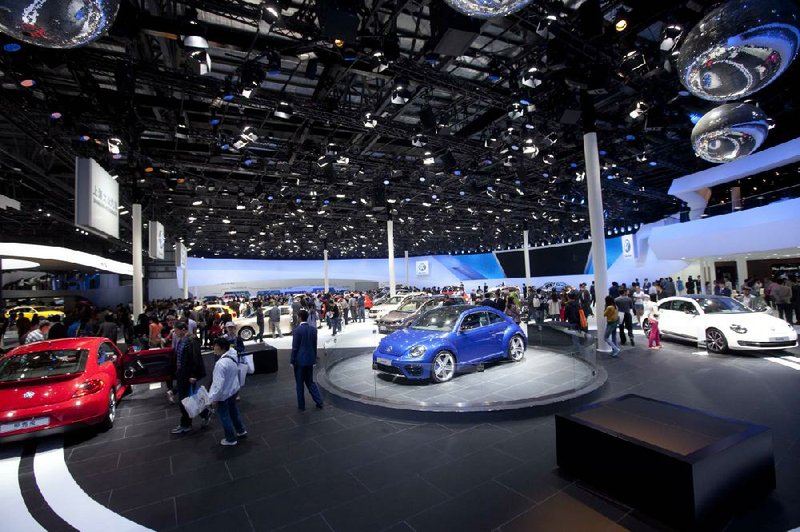SHANGHAI, China — As Volkswagen plots a course toward its goal of becoming the world’s biggest automaker by 2018, the company is making it increasingly clear that its path to global dominance runs through places such as Lanzhou, in western China.
The capital of landlocked Gansu province, which borders the Gobi Desert, is home to 11 dealerships for VW and its sister brands, Audi and Skoda. With a population of 3.6 million, and gross domestic product per capita of about $4,100, Lanzhou is the type of smaller city away from China’s prosperous east coast that VW is targeting in its next phase of expansion.
“Volkswagen’s early entry into China meant that our outlets focused on bigger, developed cities,” said Soh Weiming, the car maker’s China executive vice president. “Now, we have to expand beyond them.”
Less-developed Chinese cities are VW’s “bread and butter,” Soh said at last week’s Guangzhou Autoshow.
Increasing sales in such far-flung places is the primary challenge facing Jochem Heizmann, who took over as VW’s China country head Sept. 1.
The appointment of Heizmann, a former trucks chief and head of production planning at the company, underlines the importance of China in VW’s plans to overtake General Motors and Toyota. It is also the first time that VW’s executive overseeing China has been on the company’s group management board, a move VW says increases flexibility and streamlines its daily business there.
At stake is a market that IHS Automotive and Macquarie Securities project will eclipse the combined sales of the United States, Germany and Japan in three years. VW’s Volkswagen, Audi and Skoda brands account for a fifth of China’s passenger vehicle deliveries, well ahead of General Motors, at 9.9 percent with its Buick and Chevrolet nameplates, according to researcher LMC Automotive. Hyundai stands at No. 3 with 9.7 percent, LMC said.
VW intends to consolidate its lead with aggressive investment that outpaces that planned by rivals. VW’s China ventures have pledged to spend $12.6 billion in China through 2015, while GM says it will invest as much as $7 billion in the five years to 2015.
The German company expects that spending differential to help it win over the next wave of Chinese car buyers, made up of mostly first-timers who have little brand allegiance.
“Chinese consumers are notoriously disloyal,” said Bill Russo, president of Synergistics, a market researcher in Beijing. “Volkswagen’s challenge is continuing to build customer relationship management, and be geographically in the high growth regions.”
China’s smaller cities will account for 60 percent of new-car deliveries by the end of the decade, up from 40 percent in the past 10 years, McKinsey & Co. predicts. Car sales in so-called third- and fourth-tier cities will grow about 10 percent annually until 2020, versus 4 percent a year in Shanghai and Beijing, McKinsey said.
The country, already the world’s largest auto market, is set to grow in importance, as a drawn-out debt crisis weighs on vehicle sales in Europe.
“Globally, growth will be a bit slow,” Heizmann told reporters on Wednesday. “China is different,” he said. “In China, every business, every brand is selling especially well.”
VW’s joint ventures with SAIC Motor and China FAW operate or have announced plans for 11 factories in China, with a targeted capacity of 4 million vehicles a year by 2018. The car maker is also considering a new, 300,000-unit plant in Changsha in southern Hunan province, a person familiar with the company’s plans said this month.
VW, based in Wolfburg, Germany, is currently negotiating an extension to its tie up with FAW, with which it runs a joint venture making the Jetta sedan and the Audi A6L, a luxury model that was stretched to increase its appeal to Chinese buyers.
The automaker, which also owns Seat, Bentley and Lamborghini, said it plans to recruit more dealers, increase the number of locally made models for its Skoda brand, and introduce plug-in hybrid vehicles in the “near future.”
Sales for Skoda, the Czech car maker that VW took over after the collapse of communism, rose 6.8 percent to181,900 units China in the first nine months of this year, company data show. The country became Skoda’s biggest market in 2010, three years after it started local production.
Heizmann will also have to work to hold on to existing customers unhappy over faults this year with a direct shift gearbox system that affected some cars, said Jochen Siebert, Shanghai-based managing director at JSC Automotive Consulting, an industry researcher.
The new China chief “still has to give more reassurance to customers that there isn’t a problem with the engine,” Siebert said. “There have been a lot of problems and they need to find a way to better react.”
Business, Pages 21 on 11/27/2012
